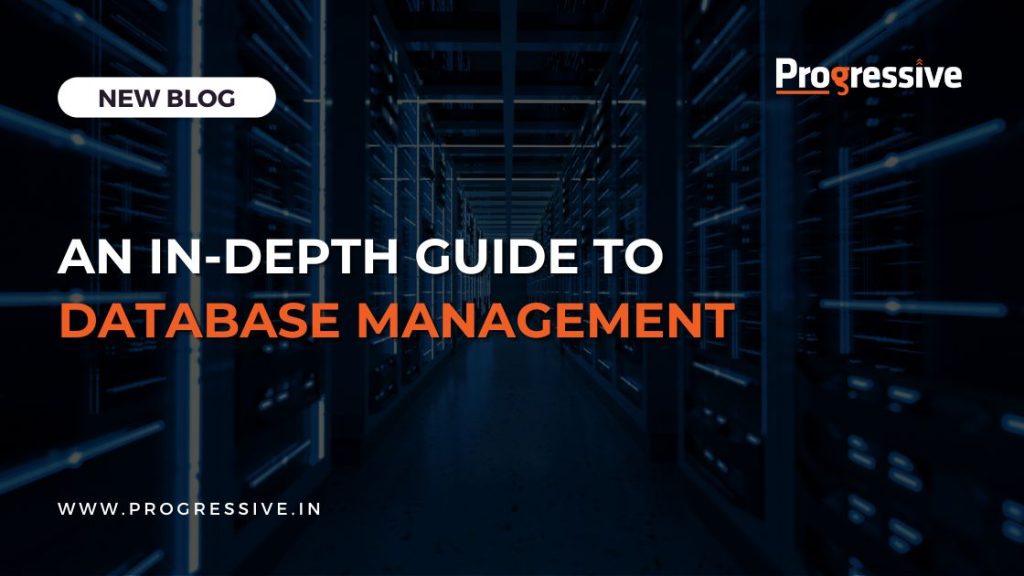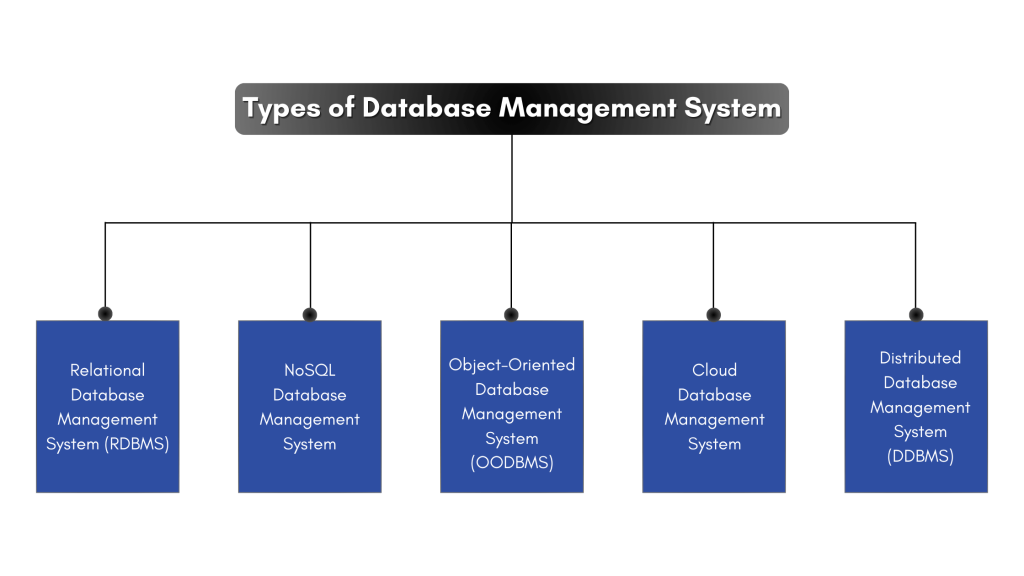
In today’s business landscape, effective data management is paramount for organizational success. A Database Management System (DBMS) serves as the cornerstone for efficiently organizing, accessing, and managing data assets. It acts as a crucial interface between databases and users, facilitating essential operations like data manipulation and retrieval. As technology advances, various types of DBMS have emerged, each tailored to specific needs and requirements. This blog delves into the nuances of DBMS, exploring its key components, tasks, types, and the diverse benefits it offers to organizations. Whether ensuring data integrity, bolstering data security, or enhancing data accessibility, a robust DBMS is indispensable for modern enterprises seeking to streamline their data management practices.
What is Database Management System: An Overview
A Database Management System (DBMS) is software that allows users to effectively manage, organize, and manipulate data stored in a database. It acts as an interface between the database and its users, allowing them to perform various operations such as adding, modifying, and deleting data.
One of the key functions of a DBMS is to provide a structured approach to data management, ensuring data integrity, security, and efficiency. It allows users to define the structure of the data, known as the database schema, which specifies the types of data that can be stored, the relationships between the data, and the constraints that apply to the data.
DBMSs also provide mechanisms for data retrieval, enabling users to query the database to retrieve specific information. These queries can be simple or complex, depending on the requirements of the user. Additionally, It supports data manipulation operations, such as inserting, updating, and deleting data, ensuring that the database remains accurate and up to date.
Overall, a DBMS plays a crucial role in modern data management, providing organizations with the tools they need to effectively store, organize, and retrieve data, ultimately enabling them to make informed decisions based on their data.
Database Management Market Research
- Base on the market research, The global enterprise database management system (DBMS) market size was USD 38450 million in 2022 and is expected to reach USD 225148.44 million in 2031, exhibiting a CAGR of 21.7% during the forecast period.
- Gartner predicts that the graph technology market, encompassing graph database management systems (DBMSs), will reach $3.2 billion by 2025, growing at a CAGR of 28.1%, driven by its rising usage, popularity, and maturity.
Key Components of Database Management System
A Database Management System (DBMS) comprises several key components that work together to ensure the efficient management and retrieval of data. These components include:
Data Definition Language (DDL)
DDL is a subset of SQL used to define and manage the structure of the database. It includes commands like CREATE, ALTER, and DROP, which are used to create, modify, and delete database objects such as tables, indexes, and views. DDL ensures that the database structure is well-defined and organized, allowing for efficient data storage and retrieval.
Data Manipulation Language (DML)
DML is used to retrieve, insert, update, and delete data in the database. It includes commands like SELECT, INSERT, UPDATE, and DELETE, which allow users to interact with the data stored in the database and ensures that data can be manipulated and managed effectively, enabling users to perform various operations on the data.
Query Processor
The query processor is responsible for processing queries written in SQL and generating an execution plan to retrieve data from the database. It includes components for query optimization, which aim to improve the efficiency and speed of query execution by selecting the most efficient execution plan based on factors such as data distribution, indexes, and join methods.
Transaction Management
Transaction management ensures the ACID properties of transactions: Atomicity, Consistency, Isolation, and Durability. It ensures that transactions are completed successfully or rolled back if they cannot be completed, maintaining the consistency and integrity of the database and crucial for ensuring data reliability and recoverability in case of failures.
Storage Manager
The storage manager is responsible for managing the storage of data on disk. It includes components for data organization, access, and retrieval, as well as buffer management and disk space allocation, ensures that data is stored efficiently and can be accessed quickly when needed.
Database Administrator (DBA) Tools
DBA tools provide administrators with the tools necessary to manage and maintain the database. This includes tools for database monitoring, performance tuning, and backup and recovery. It ensures that the database is running smoothly and efficiently, and that data is secure and accessible.
Security Management
Security management ensures that only authorized users have access to the database and that data is protected from unauthorized access, corruption, and loss. It includes components for user authentication, access control, and encryption, ensuring that data is secure and protected from threats.
Concurrency Control
Concurrency control ensures that multiple users can access and modify the database simultaneously without interfering with each other. It includes components for managing locks and ensuring data consistency in a multi-user environment. Concurrency control is essential for maintaining data integrity and consistency in a database with multiple users.
Database Management System Tasks: Ensuring Performance, Security, and Reliability
Installation and Configuration
Installation: Setting up the database software on a server or a computer system, which involves installing necessary components and configuring initial settings.
Configuration: Adjusting settings and parameters to optimize the database for specific requirements, such as memory allocation, buffer sizes, and storage configurations.
Performance Tuning
Query Optimization: Analyzing and modifying database queries to improve their efficiency and speed.
Indexing: Creating and managing indexes to speed up data retrieval operations.
Resource Management: Monitoring and managing system resources (CPU, memory, disk I/O) to ensure optimal database performance.
Database Design Optimization: Modifying database schema and structures to enhance performance.
Upgrades and Migration
Upgrades: Updating the database software to a newer version, which may involve modifying database schema and migrating data to the new version.
Migration: Moving a database from one environment to another, such as from on-premises to the cloud or from one database system to another.
Troubleshooting, & Bug Fixes
Troubleshooting: Identifying and resolving issues that affect database performance or functionality, such as errors, failures, or performance bottlenecks.
Bug Fixes: Applying patches or updates to fix bugs or vulnerabilities in the database software.
Database Security
Access Control: Managing user access to the database and ensuring that only authorized users can access sensitive data.
Data Encryption: Implementing encryption techniques to protect data both at rest and in transit.
Auditing and Monitoring: Monitoring database activity and auditing access logs to detect and respond to security threats.
Data Masking and Redaction: Concealing or obfuscating sensitive data to protect it from unauthorized access.
Backup and Recovery
Backup: Creating copies of the database to protect against data loss due to hardware failures, disasters, or human errors.
Recovery: Restoring the database to a previous state using backups in the event of data loss or corruption.
Types of Database Management System
Relational Database Management System (RDBMS)
Data Model: Data Model: Structuring data into tables comprising rows and columns.
Query Language: Uses Structured Query Language (SQL) for querying and managing data.
ACID Properties: Ensures data integrity with Atomicity, Consistency, Isolation, and Durability.
Examples: MySQL, PostgreSQL, Oracle Database, SQL Server.
Use Cases: Ideal for applications that demand intricate queries and transactions, like e-commerce platforms and financial systems.
NoSQL Database Management System
Data Model: Supports flexible schema and can store unstructured, semi-structured, or structured data.
Types: Includes key-value stores, document stores, column-family stores, and graph databases.
Examples: MongoDB (Document Store), Cassandra (Column-Family Store), Redis (Key-Value Store), Neo4j (Graph Database).
Use Cases: Ideal for handling large volumes of data with varying structures, common in big data and real-time analytics applications.
Object-Oriented Database Management System (OODBMS)
Data Model: Stores data in the form of objects, similar to object-oriented programming concepts.
Supports: Encapsulation, inheritance, polymorphism.
Examples: ObjectDB, ObjectStore.
Use Cases: Suitable for applications with complex data structures and relationships, such as CAD/CAM, GIS, and multimedia systems.
Cloud Database Management System
Designed for: Cloud computing environments, offering scalability, high availability, and flexible pricing models.
Examples: Amazon Aurora, Google Cloud Bigtable, Microsoft Azure SQL Database.
Distributed Database Management System (DDBMS)
Manages: Data distributed across multiple locations or nodes.
Examples: Apache HBase, CockroachDB.
Use Cases: Useful for applications requiring scalability and fault tolerance, often seen in distributed systems and big data processing.

Advantages of Data Base Management
Data Organization: DBMS helps organize data in a structured manner, making it easier to retrieve, update, and manage.
Improved Efficiency: DBMS automates various data management tasks, including entry, storage, retrieval, and backup, thereby enhancing overall operational efficiency.
Data Integrity: DBMS ensures data integrity by enforcing constraints and rules, preventing inconsistencies and errors in the database.
Security of Data: DBMS offers security functionalities to safeguard data from unauthorized access, ensuring confidentiality, integrity, and availability.
Consistency In Data: DBMS helps maintain data consistency by ensuring that data is accurate and up to date across the database.
Cost-Effective: While initial implementation costs may be high, DBMS can be cost-effective in the long run due to improved efficiency, reduced data redundancy, and better data management.
Scalability: DBMS can scale to accommodate growing amounts of data and users, ensuring that the database remains efficient and responsive.
Accessibility: DBMS allows multiple users to access the database simultaneously, ensuring that users can retrieve and modify data as needed.
Data Recovery: DBMS provides mechanisms for data backup and recovery, ensuring that data can be restored in case of data loss or corruption.
Data Independence: DBMS allows data to be stored independently of the applications that use it, enabling changes to the database structure without affecting the applications.
Optimize Your Data Management with Progressive Infotech’s Database Management Services
In summary, Database Management Systems (DBMS) are fundamental to modern data management, offering a structured approach to organizing, accessing, and managing data. They serve as a vital interface between databases and users, enabling essential operations such as data manipulation and retrieval. The key components of a DBMS work in harmony to ensure efficient data management, while various types of DBMS cater to specific needs and requirements. Whether enhancing data integrity, bolstering data security, or improving data accessibility, a robust DBMS is indispensable for organizations aiming to streamline their data management practices and make informed decisions based on their data.
At Progressive, we understand the importance of efficient database management in driving business success. Our DBMS services are designed to streamline your operations, improve data security, and ensure optimal performance of your databases. Whether you need help with database design, implementation, maintenance, or optimization, our team of experts is here to help. Take the first step towards better database management today. Contact us to learn more and see how we can help your business thrive!